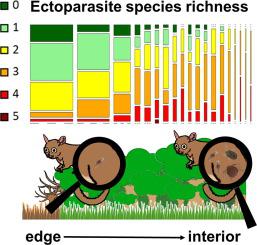当前位置:
X-MOL 学术
›
Int. J. Parasitol.
›
论文详情
Our official English website, www.x-mol.net, welcomes your feedback! (Note: you will need to create a separate account there.)
Forest edges affect ectoparasite infestation patterns of small mammalian hosts in fragmented forests in Madagascar.
International Journal for Parasitology ( IF 4 ) Pub Date : 2020-03-26 , DOI: 10.1016/j.ijpara.2020.01.008 Frederik Kiene 1 , Bertrand Andriatsitohaina 2 , Malcolm S Ramsay 3 , Herinjatovo Rakotondramanana 4 , Romule Rakotondravony 5 , Ute Radespiel 6 , Christina Strube 7
International Journal for Parasitology ( IF 4 ) Pub Date : 2020-03-26 , DOI: 10.1016/j.ijpara.2020.01.008 Frederik Kiene 1 , Bertrand Andriatsitohaina 2 , Malcolm S Ramsay 3 , Herinjatovo Rakotondramanana 4 , Romule Rakotondravony 5 , Ute Radespiel 6 , Christina Strube 7
Affiliation

|
Habitat loss and fragmentation drive the worldwide depletion of biodiversity. Although it is known that anthropogenic disturbances severely affect host and ecosystem integrity, effects on parasites are largely understudied. This study aims to investigate if and how habitat fragmentation affects the composition of ectoparasite communities on small mammalian hosts in two networks of dry deciduous forest fragments in northwestern Madagascar. Forest sites differing in size, proportion of edge habitat and host density were studied in the Ankarafantsika National Park and in the Mariarano region. A total of 924 individuals of two mouse lemur species, Microcebus murinus (n = 200) and Microcebus ravelobensis (n = 426), and two rodent species, endemic Eliurus myoxinus (n = 114) and introduced Rattus rattus (n = 184), were captured to assess ectoparasite infestations. Ectoparasite prevalence and ectoparasite species richness were statistically related to nine ecological variables applying generalized linear mixed models. Hosts harbored ticks (Haemaphysalis microcebi), mites (Schoutedenichia microcebi, Listrophoroides spp., Laelaptidae gen. spp.) and sucking lice (Lemurpediculus spp., Polyplax sp., Hoplopleuridae gen. sp.). Parasite prevalence differed significantly between host species for all detected parasite taxa. Proximity to the forest edge led to a significant reduction in ectoparasites. Parasite-specific edge effects were observed up to a distance of 750 m from the forest edge. The obtained results imply that habitat fragmentation impacts ectoparasite communities, in particular by negatively affecting temporary parasite species. The results are best explained by an interplay of parasite life cycles, responses to changes in abiotic factors induced by edges and host-specific responses to habitat fragmentation. The negative responses of most studied ectoparasite taxa to forest edges and habitat fragmentation demonstrate their ecological vulnerability that may eventually threaten the integrity of ecosystems and potentially impact ectoparasite biodiversity worldwide.
中文翻译:

森林边缘影响马达加斯加零散森林中小型哺乳动物寄主的外寄生虫侵染方式。
生境的丧失和破碎化推动了生物多样性的全球枯竭。尽管已知人为干扰会严重影响寄主和生态系统的完整性,但对寄生虫的影响在很大程度上尚未得到研究。这项研究的目的是调查马达加斯加西北部两个干燥的落叶林碎片网络中,栖息地碎片化是否以及如何影响小型哺乳动物宿主上的寄生虫群落组成。在Ankarafantsika国家公园和Mariarano地区研究了大小,边缘生境比例和寄主密度不同的林地。共有924个个体,分为两种小鼠狐猴物种,即鼠尾草微鼠(n = 200)和鼠尾草微鼠(n = 426),还有两种啮齿动物,特有的Eliurus myoxinus(n = 114)和引入的Rattus rattus(n = 184),被捕获以评估体外寄生虫侵扰。利用广义线性混合模型,寄生虫的流行率和寄生虫的物种丰富度与九个生态变量在统计上相关。寄主有tick(Haemaphysalis microcebi),螨(Schoutedenichia microcebi,Listrophoroides spp。,Laelaptidae gen.spp。)和吮吸虱子(Lemurpediculus spp。,Polyplax sp。,Hoplopleuridae gen.sp.)。在所有检测到的寄生虫类群中,宿主物种之间的寄生虫流行率差异显着。靠近森林边缘导致外寄生物显着减少。在距森林边缘750 m处观察到寄生虫特有的边缘效应。获得的结果表明,生境破碎化会影响外寄生虫群落,特别是通过对临时寄生虫物种产生负面影响。寄生虫生命周期,对边缘诱导的非生物因子变化的响应以及宿主对生境破碎的特定响应之间的相互作用,可以最好地说明结果。大多数研究过的外寄生生物分类单元对森林边缘和生境破碎化的负面反应表明它们的生态脆弱性最终可能威胁到生态系统的完整性,并可能影响全世界的外寄生生物多样性。
更新日期:2020-03-26
中文翻译:

森林边缘影响马达加斯加零散森林中小型哺乳动物寄主的外寄生虫侵染方式。
生境的丧失和破碎化推动了生物多样性的全球枯竭。尽管已知人为干扰会严重影响寄主和生态系统的完整性,但对寄生虫的影响在很大程度上尚未得到研究。这项研究的目的是调查马达加斯加西北部两个干燥的落叶林碎片网络中,栖息地碎片化是否以及如何影响小型哺乳动物宿主上的寄生虫群落组成。在Ankarafantsika国家公园和Mariarano地区研究了大小,边缘生境比例和寄主密度不同的林地。共有924个个体,分为两种小鼠狐猴物种,即鼠尾草微鼠(n = 200)和鼠尾草微鼠(n = 426),还有两种啮齿动物,特有的Eliurus myoxinus(n = 114)和引入的Rattus rattus(n = 184),被捕获以评估体外寄生虫侵扰。利用广义线性混合模型,寄生虫的流行率和寄生虫的物种丰富度与九个生态变量在统计上相关。寄主有tick(Haemaphysalis microcebi),螨(Schoutedenichia microcebi,Listrophoroides spp。,Laelaptidae gen.spp。)和吮吸虱子(Lemurpediculus spp。,Polyplax sp。,Hoplopleuridae gen.sp.)。在所有检测到的寄生虫类群中,宿主物种之间的寄生虫流行率差异显着。靠近森林边缘导致外寄生物显着减少。在距森林边缘750 m处观察到寄生虫特有的边缘效应。获得的结果表明,生境破碎化会影响外寄生虫群落,特别是通过对临时寄生虫物种产生负面影响。寄生虫生命周期,对边缘诱导的非生物因子变化的响应以及宿主对生境破碎的特定响应之间的相互作用,可以最好地说明结果。大多数研究过的外寄生生物分类单元对森林边缘和生境破碎化的负面反应表明它们的生态脆弱性最终可能威胁到生态系统的完整性,并可能影响全世界的外寄生生物多样性。

























 京公网安备 11010802027423号
京公网安备 11010802027423号